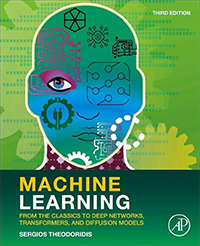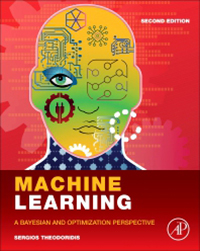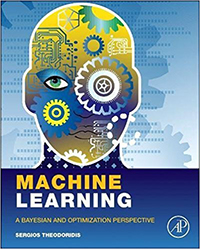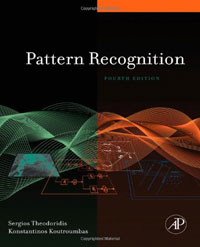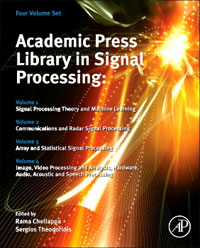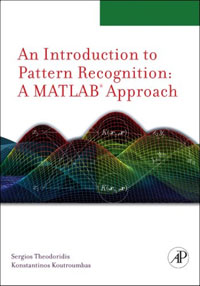Books
Machine Learning: From the Classics to Deep Networks, Transformers, and Diffusion Models
ISBN: 9780128015223 (1st edition), ISBN: 9780128188033 (2nd edition,) ISBN: 9780443292385 (3rd edition)
ABOUT:
Machine Learning: From the Classics to Deep Networks, Transformers and Diffusion Models, Third Edition starts with the basics, including least squares regression and maximum likelihood methods, Bayesian decision theory, logistic regression, and decision trees. It then progresses to more recent techniques, covering sparse modelling methods, learning in reproducing kernel Hilbert spaces and support vector machines. Bayesian learning is treated in detail with emphasis on the EM algorithm and its approximate variational versions with a focus on mixture modelling, regression and classification. Nonparametric Bayesian learning, including Gaussian, Chinese restaurant, and Indian buffet processes are also presented. Monte Carlo methods, particle filtering, probabilistic graphical models with emphasis on Bayesian networks and hidden Markov models are treated in detail. Dimensionality reduction and latent variables modelling are considered in depth. Neural networks and deep learning are thoroughly presented, starting from the perceptron rule and multilayer perceptrons and moving on to convolutional and recurrent neural networks, adversarial learning, capsule networks, deep belief networks, GANs, and VAEs. The book also covers the fundamentals on statistical parameter estimation and optimization algorithms.
Focusing on the physical reasoning behind the mathematics, without sacrificing rigor, all methods and techniques are explained in depth, supported by examples and problems, providing an invaluable resource to the student and researcher for understanding and applying machine learning concepts.
New to this edition:
The new material includes an extended coverage of attention transformers, large language models, self-supervised learning and diffusion models
REVIEWS:
"Machine Learning: A Bayesian and Optimization Perspective, Academic Press, by Sergios Theodoridis is a wonderful book, up to date and rich in detail. It covers a broad selection of topics ranging from classical regression and classification techniques to more recent ones including sparse modeling, convex optimization, Bayesian learning, graphical models and neural networks, giving it a very modern feel and making it highly relevant in the deep learning era. While other widely used machine learning textbooks tend to sacrifice clarity for elegance, Professor Theodoridis provides you with enough detail and insights to understand the "fine print". This makes the book indispensable for the active machine learner."
Prof. Lars Kai Hansen, DTU Compute - Dept. Applied Mathematics and Computer Science Technical University of Denmark
"Before the publication of Machine Learning: A Bayesian and Optimization Perspective, I had the opportunity to review one of the chapters in the book (on Monte Carlo methods). I have published actively in this area, and so I was curious how S. Theodoridis would write about it. I was utterly impressed. The chapter presented the material with an optimal mix of theoretical and practical contents in very clear manner and with information for a wide range of readers, from newcomers to more advanced readers. This raised my curiosity to read the rest of the book once it was published. I did it and my original impressions were further reinforced. S. Theodoridis has a great capability to disentangle the important from the unimportant and to make the most of the used space for writing. His text is rich with insights about the addressed topics that are not only helpful for novices but also for seasoned researchers. It goes without saying that my department adopted his book as a textbook in the course on machine learning."
Petar M. Djurić, Ph.D. SUNY Distinguished Professor Department of Electrical and Computer Engineering Stony Brook University, Stony Brook, USA.
"As someone who has taught graduate courses in pattern recognition for over 35 years, I have always looked for a rigorous book that is current and appealing to students with widely varying backgrounds. The book on Machine Learning by Sergios Theodoridis has struck the perfect balance in explaining the key (traditional and new) concepts in machine learning in a way that can be appreciated by undergraduate and graduate students as well as practicing engineers and scientists. The chapters have been written in a self-consistent way, which will help instructors to assemble different sections of the book to suit the background of students"
Rama Cellappa, Distinguished University Professor, Minta Martin Professor of Engineering, Chair, Department of Electrical and Computer Engineering, University of Maryland, USA. hidePattern Recognition
ISBN: 9781597492720
ABOUT:
The book has been among the best selling titles of Academic Press and it has also been translated into Chinese and into Greek (more than 25000 copies sold).In this book, Supervised, Semisupervised and Unsupervised (Clustering) are treated in an equally balanced way.
REVIEWS:
"This book is an excellent reference for pattern recognition, machine learning, and data mining. It focuses on the problems of classification and clustering, the two most important general problems in these areas. This book has tremendous breadth and depth in its coverage of these topics; it is clearly the best book available on the topic today. The new edition is an excellent up-to-date revision of the book. I have especially enjoyed the new coverage provided in several topics, including new viewpoints on Support Vector Machines, and the complete in-depth coverage of new clustering methods. This is a standout characteristic of this book: the coverage of the topics is solid, deep, and principled throughout. The book is very successful in bringing out the important points in each technique, while containing lots of interesting examples to explain complicated concepts. I believe the section on dimensionality reduction is an excellent exposition on this topic, among the best available, and this is just one example. Combined with a coverage unique in its extend, this makes the book appropriate for use as a reference, as a textbook for upper level undergraduate or graduate classes, and for the practitioner that wants to apply these techniques in practice. I am a professor in Computer Science. Although pattern recognition is not my main focus, I work in the related fields of data mining and databases. I have used this book for my own research and, very successfully, as teaching material. I would strongly recommend this book to both the academic student and the professional."
Dimitrios Gunopoulos, University of California, Riverside, USA
"I cut my pattern recognition teeth on a draft version of Duda and Hart (1973). Over subsequent decades, I consistently did two things: (i) recommended Duda and Hart as the best book available on pattern recognition; and (ii) wanted to write the next best book on this topic.nbsp; I stopped (i) when the first edition ofnbsp;S. Theodoridis andnbsp;K. Koutroumbas'nbsp;book appeared, and it supplanted the need for (ii) It was, and is, the best book that has been written on the subject since Duda and Hart's seminal original text. Buy it - you'll be happy you did."
Jim Bezdek, University of West Florida and Senior Fellow, U. of Melbourne (Australia)
"I consider the fourth edition of the book Pattern Recognition, by S. Theodoridis and K. Koutroumbas as the Bible of Pattern Recognition."
Simon Haykin, McMaster University, Canada
"I have taught a graduate course on statistical pattern recognition for more than twenty five years during which I have used many books with different levels of satisfaction. Recently, I adopted the book by Theodoridis and Koutroumbas (4th edition) for my graduate course on statistical pattern recognition at University of Maryland. This course is taken by students from electrical engineering, computer science, linguistics and applied mathematics. The comprehensive book by Thedoridis and Koutroumbas covers both traditional and modern topics in statistical pattern recognition in a lucid manner, without compromising rigor. This book elegantly addresses the needs of graduate students from the different disciplines mentioned above. This is the only book that does justice to both supervised and unsupervised (clustering) techniques. Every student, researcher and instructor who is interested in any and all aspects of statistical pattern recognition will find this book extremely satisfying. I recommend it very highly."
Rama Chellappa, University of Maryland
"The book Pattern Recognition, by Profs. Sergios Theodoridis and Konstantinos Koutroumbas, has rapidly become the "bible" for teaching and learning the ins and outs of pattern recognition technology.nbsp; In my own teaching, I have utilized the material in the first four chapters of the book (from basics to Bayes Decision Theory to Linear Classifiers and finally to Nonlinear Classifiers) in my class on fundamentals of speech recognition and have found the material to be presented in a clear and easily understandable manner, with excellent problems and ideas for projects.nbsp; My students have all learned the basics of pattern recognition from this book and I highly recommend it to any serious student in this area."
Prof. Lawrence Rabiner hide
